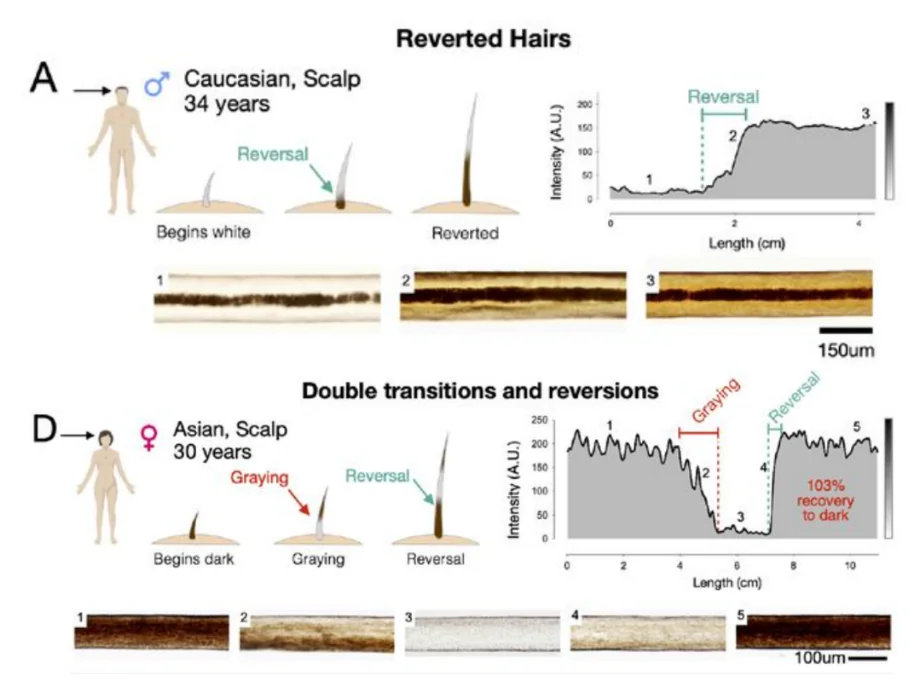A team of researchers have discovered a novel way to study the process of hair graying, finding it potentially reversible and linked to psychological stress.
The abundant anecdotal evidence of hair graying overnight (or, as Shakespeare put it in Henry IV: “Thy father’s beard is turned white with the news”), may have finally received a scientific certificate of authenticity. A group of researchers set out to compile a comprehensive model of hair graying and discovered that individual hairs can rapidly gray as a result of psychological stress and then revert to their normal colored state [1].
Tree rings – only in hairs
As the authors note at the beginning of their paper: “Hair graying is a universal hallmark of aging, but its mechanisms are insufficiently understood and its reversibility in humans remains uncertain.” This natural phenomenon may indeed have been overlooked due to its triviality. What can be more natural than hair graying with age? To fill this void, the researchers decided to develop a quantitative approach to hair graying, including proteomic signatures for gray and pigmented hair. To do so, they digitized hair pigmentation patterns (HPPs) across the length of individual human hairs. Knowing the average speed of hair growth, they transformed HPPs into a temporal view of each hair’s development. This is somewhat similar to dendrochronology, a method of deducing the history of a tree from its rings that represent elapsed years.
In accordance with previous research, the scientists found that hair graying is the result of melanosome loss. Gray hairs contain 98% fewer melanosomes (organelles responsible for the synthesis, storage, and transport of melanin) than their normally pigmented peers.
To create their “tree ring” model, the researchers had analyzed individual hairs taken from 14 individuals of different genders, ages, and racial backgrounds. They were surprised to find a few instances of quick hair graying and reversal, and sometimes double reversal, all during one hair growth cycle that usually lasts 3-5 years. The reversals seemed to happen in every direction: some hairs started growing pigmented and then turned white, some started growing white and then reverted to the pigmented state. In double reversals, hairs would either start as white, revert to pigmented and then back to white, or vice versa, creating “striped” patterns.

Is stress responsible?
Among the 14, three individuals had multiple two-colored hairs collected within a month. In each case, the hairs were located a few centimeters from each other, yet their chronological patterns of graying turned out to be strikingly similar; graying and its reversal happened at roughly the same time in all hairs. The researchers then hypothesized that both greying and its reversal could have been triggered by abrupt changes in the levels of psychological stress.
Curiously, despite all the anecdotal evidence of stress causing gray hair, it has only been scientifically confirmed in mice [2]. Yet, stress has been linked to other aging-related processes in humans, such as telomere shortening and DNA methylation [3]. Using their chronological HPP model and stress assessment by the subjects, the researchers have been able to link graying/repigmentation events in two cases to distinct shifts in the levels of stress (separation from a spouse in one case). Given the small sample size, it is early to make definitive conclusions, but the researchers suggest that they have successfully demonstrated the robustness of their method. They also predict that HPP analysis may one day be used to provide information about the psychobiological state of the individual in the past.
Sadly, the researchers do not imply that hair graying can be artificially reversed by lowering stress levels. According to the study, this spontaneous reversal can only happen in relatively young individuals – or, rather, in relatively young hairs, since every hair’s biological state is unique. However, the mechanisms behind this phenomenon can potentially be utilized and amplified to revert hair graying, even in older people.
The proteomic profile of hair graying
Delving deeper into the process of graying, the researchers performed a comprehensive proteomic analysis of dark and gray hairs. They were able to isolate several proteins that were distinctively up- or down-regulated in gray hairs. Most of these proteins are linked to mitochondrial energy metabolism, such as NAD/NADH pathways, which play an important role in other aging processes as well. Some of these processes have already been shown to be reversible [4]. This correlates with this study’s findings that hair graying can be reversed as well. The researchers stopped short of marking any of the proteins as potential targets for intervention, but their work can provide a good starting point for future research.
Our data strongly support the notion that human aging is not a linear and irreversible biological process and may, at least in part, be halted or even reversed. Our method to map the rapid (weeks to months) and natural reversibility of human hair graying may thus provide a powerful model to explore the malleability of human aging within time scales substantially smaller than the human lifespan.
Conclusion
Although not life-threatening, as many other age-related changes are, hair graying is arguably the most symbolic one. The current findings demonstrate that hair graying is reversible, that it is linked to other aging processes, and, therefore, can potentially respond to similar treatments. This team’s proteomic analysis can help future researchers discover such treatments.
Literature
[1] Rosenberg, A., Rausser, S., Ren, J., Mosharov, E., Sturm, G. M., Ogden, R. T., … & Picard, M. (2020). Human Hair Graying is Naturally Reversible and Linked to Stress. bioRxiv.
[2] Zhang, B. et al. Hyperactivation of sympathetic nerves drives depletion of melanocyte stem cells. Nature 577, 676–681, doi:10.1038/s41586-020-1935-3 (2020).
[3] Epel, E. S. et al. Accelerated telomere shortening in response to life stress. Proc Natl Acad Sci U S A 101, 17312–17315, doi:0407162101 [pii]10.1073/pnas.0407162101 (2004).
[4] Singh, B., Schoeb, T. R., Bajpai, P., Slominski, A. & Singh, K. K. Reversing wrinkled skin and hair loss in mice by restoring mitochondrial function. Cell Death Dis 9, 735, doi:10.1038/s41419-018-0765-9 (2018).







